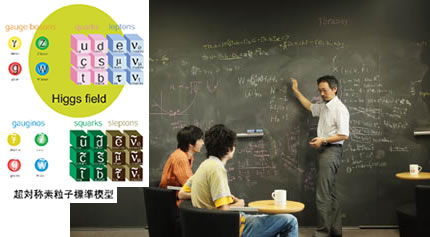Particle and Nuclear Theory
Particle Theory and Cosmology
http://www.tuhep.phys.tohoku.ac.jp/index.html
Staff
| Professor : | Yukinari Sumino HP | Fuminobu Takahashi | Masahiro Yamaguchi | |
| Associate Professor : | Hiroshi Ishikawa | Kazunori Nakayama | Masaki Yamada | Kazuya Yonekura |
| Assistant Professor : | Naoya Kitajima | Masahiro Hotta | Youichi Yamada |
Rsearch

The subjects of particle physics are the elementary particles – the most basic constituents of matter – and their interactions – the most fundamental law of Nature.
Particle physics is also called high energy physics, since the short-distance physics corresponds to the high-energy physics because of the uncertainty principle in quantum mechanics.
The theory of particle physics is based on relativistic quantum field theory. In particular, gauge theories are most important. Four interactions are known presently to act among particles: They are the electromagnetic interaction, the weak interaction, the strong interaction and the gravitational interaction. The first three interactions, together with the Higgs mechanism for electroweak symmetry breaking, are merged into a single gauge theory, the Standard Model, which is surely one of the most important achievements in physics of the last century.
The standard model is a beautiful theory with rich structure, and it explains almost all experimental data. However, it leaves many unanswered questions such as the stability of the electroweak scale. These questions are expected to lead us to more fundamental theory of nature.
There are various experiments which search for physics beyond the standard model, both in the energy and luminosity frontiers. For the development of particle physics, it is indispensable to analyze physical phenomena with greater precision, and also develop quantum field theory which describes them. For these purposes, it is particularly important to understand QCD which describes strong interactions. QCD is a difficult theory because of its strong dynamics, and it has many interesting properties such as color confinement of quarks. Due to the asymptotic freedom, it is described in high energy regions by elementary particles such as gluons and quarks rather than nucleons. It is an important subject in high energy physics to get better understandings of quantum field theory such as QCD more deeply.
Particle physics is intimately related to cosmology. Many kinds of particles, inaccessible in laboratory, must have played essential roles in the beginning of the universe. The present structure of the universe might be a result of interactions among many unknown particles activated by a high temperature at that time.
Just after the beginning of the universe, it is believed that there is a period of time, called inflation, during which the universe undergoes rapid expansion due to large vacuum energy. The energy is then released into radiation, leading to the big bang, which is followed by cooling by expansion and some phase transitions, and finally to the evolution into the present universe. The knowledge of particle physics is indispensable for the study of the early universe, and the study of the early universe can give new information to particle physics. From this point of view, the early universe is actively investigated based on particle physics, and it is also stimulated by cosmic microwave background, gravitational lensing, and primordial abundances of nuclei. In particular, the constituents of the present universe are mostly dark energy and dark matter.
They cannot be explained in the current framework of the standard model, their existence suggests new physics beyond the standard model. It is an important task for us living in this universe to understand these constituents.
Gravity is described by general relativity as a classical theory. However, its quantization is an important problem yet to be solved. Superstring theory is a good candidate for the unification of all interactions including quantum gravity. It predicts the existence of graviton. Also, several superstring theories which were considered to be different in the past are now understood to be just different aspects of the same theory, thanks to the discovery of duality. Therefore, it is believed that this is a unique theory with no room for modification, and it is expected to be the final theory of fundamental physics.
Superstring theory also has extremely rich structure, and it is developed together with quantum field theory, mathematics, and other areas of physics. It has also led to unexpected conceptual developments such as the AdS/CFT correspondence which is a duality between quantum gravitational theories and quantum field theories. Quantum field theory is essentially important to superstring theory, and the study of superstring theory also leads to new developments in quantum field theory. Due to its extremely rich structure, we are still far from the complete understanding and it is important to continue investigation of various aspects.
In this way we are investigating various topics of particle physics,
cosmology, quantum field theory and superstring theory widely from the ultimate microscope to the ultimate macroscope.

